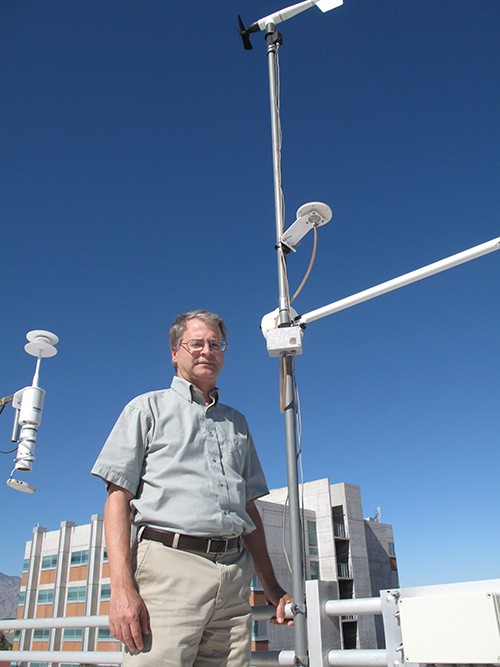Alternative energy research has an under-utilized component — wind energy, according to UA and Tucson officials.
Arizona’s first wind farm, the Dry Lake Wind Project, southwest of Winslow, Ariz., has been able to create 30 412-foot wind turbines that can create 63 megawatts — or 15,000 homes’ worth — of energy since late 2009. Now, UA researcher Israel Wygnanski has created a turbine with the potential to create double the wind power of any other.
But Mike Leuthold, an aerospace and mechanical engineering researcher, said there’s only so much wind that Arizona can harness.
“”The best thing in Arizona is solar,”” Leuthold said. “”There’s much more sun here than there is wind. The problem is in the summertime, when we need the most energy for air conditioning, the wind doesn’t blow very much.””
Less than one percent of Arizona is capable of creating a distinct amount of wind energy, with 10,904.1 megawatts of potential installed capacity generating 30,616 gigawatts of power for the state, according to an analysis of National Renewable Energy Laboratory statistics.
Joe Salkowski, media spokesperson for Tucson Electric Power and UniSource Energy, agreed that wind is a supplement to solar, rather than its own powerful source.
“”There are many parts of the country where wind energy is the most popular form of renewable energy because it costs significantly less than solar energy, but in Southern Arizona, we don’t have a great deal of utility-grade wind energy,”” Salkowski said. “”There are some areas of the state where it blows steady and hard enough to built utility-scale wind farms but those are outside of Tucson.””
The Kingman area and parts of Mohave County are both more apt for wind energy collection. A 10-megawatt wind farm built by Western Wind and operated by UniSource Energy Systems, a sister company to TEP, will also provide more wind to Arizona.
Right now, wind energy has little impact on the installed or reserved renewable energy capacity TEP provides customers.
TEP’s renewable energy sources include two systems with the potential for 11 kilowatts of wind-generated electricity: one utility-scale system, which can generate two kilowatts, and three residential grade systems with a 9-kilowatt capacity.
Rebates for small businesses and those who want to invest in smaller wind turbines are available “”to make sure the option is there,”” he said.
Salkowski said that utility companies face problems when it comes to storage of intermittent renewable energy.
“”The wind stops blowing, all of a sudden your energy goes away and that’s a huge problem,”” he said. “”Before we can fully integrate wind, we need to improve the storage capacity of our grid.””
But Arizona utilities have been working to create 15 percent of their power from renewable sources by 2025 to meet legislative requirements, so plans for wind turbines and solar panels have been proposed across the state and outside of it.
TEP has signed a contract with a company in Deming, N.M., to develop a 50-megawatt wind farm expected to be complete at the end of this year. Although TEP currently doesn’t utilize much in the way of wind resource as part of the energy mix, Salkowski said, adding wind into their renewable energy bank by next year could at least double that impact.
The Arizona Research Institute for Solar Energy, AzRISE, is also doing work in solar energy storage, something that can be easily translated to wind, Salkowski said.
A compressed air storage system to be housed in the UA Solar and Technology Park is part of solving this problem, he said.
Leuthold said the work the UA does with places like Idaho Power, where 20 percent of their energy output is reliant on wind, helps in forecasting and weather models produced by the university. But he said Arizonans shouldn’t hold their breath for us to achieve the same level of sustainability through wind energy.
“”Certainly not here, not 20 percent wind. It’s just not windy enough,”” Leuthold said. “”It’s a lot easier and probably less cost than a large solar insulation but it’s just not a mature technology.””
He said that wind “”makes sense for other places,”” like Idaho, or the Columbia River in Washington where there is significant wind, but that Arizona is at a disadvantage with its mountains and metropolitan areas.
“”When the wind dies, they have an easy and cheap standby,”” Leuthold said of the northwest and Midwest. “”In Arizona we don’t have that utility, we’d have to use natural gas plants to do that.””
But Leuthold said his forecasting system, which is 30 percent more accurate than other forecast models, can predict wind speeds up to three days in advance. He said this could allow Arizonans to see, of our smaller amount of wind, what we can use.
The product will eventually be spun out as a commercial product through the university and is already being used by the U.S. Air Force, the aforementioned Salt River Project and Tucson Electric Power.
“”There’s much more sun here than there is wind,”” he said. “”But it’s good to have both.””









